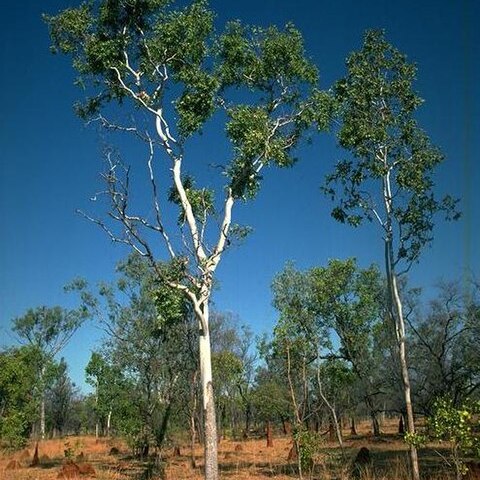Tree 18 m tall, usually deciduous in the late dry season. Forming a lignotuber.Bark rough, persistent, tessellated and blackish grey for basal 0.5–3 m of trunk, rarely the whole trunk, then abruptly becoming smooth, white to pale grey, shedding in thin flakes.Branchlets sometimes have oil ducts visible in the pith; younger branchlets setose to scabrid with bristle-glands. In this species the bristle-glands usually lack simple hairs, but any that are present are short.Juvenile growth (coppice or field seedlings to 50 cm): stems rounded in cross-section, setose with bristle-glands to sparsely so, sometimes only present below the leaf axils; juvenile leaves always sessile, opposite, sub-orbicular to cordate or ovate-elliptic, 9.8–23 cm long, 4.2–17 cm wide, base usually amplexicaul or rounded, apex rounded, margin entire, green, dull, setose with bristle-glands. Crown of intermediate to adult leaves, opposite or sometimes ± sub-opposite, sessile or shortly petiolate, petioles 0–0.3(0.5) cm long; blade cordate to broadly elliptic or lanceolate to ovate, (4)6–16(21) cm long, (1.5)2.5–10.3 cm wide, ± undulate, base amplexicaul to lobed or rounded, margin entire or distantly sub-crenulate, apex rounded or broadly pointed, concolorous, dull, green, setose with bristle-glands that usually lack or have few short simple hairs, side-veins at greater than 45° to midrib, reticulation dense to very dense, intramarginal vein present, oil glands obscure. The new season’s leaf growth is often reddish purple at first.Inflorescence borne on leafless sections of branchlets below new season’s leaf growth, axillary compound and greatly condensed, the rhachis consisting of a basal internode ca 0.1–1 cm long, a second internode absent or if present 0.1–0.7 cm long, further internodes sometimes present and always short (Mature buds pyriform (0.4–0.7 cm long, 0.4–0.5 cm wide), smooth, scar present (outer operculum shed early), operculum shallowly rounded, sometimes apiculate, stamens inflexed, all fertile, anthers oblong, dorsifixed, versatile, dehiscing by longitudinal slits, style long and straight, stigma tapered, locules 3, the ovules not arranged in distinct vertical rows on the placentae but sometimes appearing to be in ± 5 rows. Flowers creamy white.Fruit pedicellate (pedicels 1–3.5 cm long), cylindrical to barrel-shape to campanulate, 0.7–1.5 cm long, 0.6–1.2 cm wide, thin-walled, disc descending vertically, valves 3, enclosed.Seeds brown, 3–5 mm long, saucer-shaped, smooth, hilum ventral. Cultivated seedlings (measured at ca node 10): cotyledons large, ± orbicular; stems rounded in cross-section, setose with long bristle-glands; leaves sessile, opposite for at least 12+ nodes, ovate to elliptic, 4.8–11 cm long, 1.2–5.7 cm wide, base amplexicaul to rounded, apex pointed, dull, green, setose with bristle-glands on both sides.
More
Tree to 15 m, often straggly or crooked, ±deciduous. Bark tessellated, grey or grey-brown to 8 m, smooth and white above. Juvenile leaves sessile or shortly petiolate, broadly lanceolate, cordate, scabrous, discolorous. Leaves on mature trees opposite or alternate, sessile or petiolate, ovate, elliptic or broadly lanceolate, obtuse, thick; lamina 7.5–15 cm long, 2.5–10 cm wide, green, scabrous but wearing smooth, concolorous; lateral veins prominent, at 50°–70°; intramarginal vein close to margin, lateral veins often uniting to form a second irregular vein up to 6 mm from margin; petiole absent or terete, up to 2 cm long. Conflorescence axillary, compound, many-flowered, sessile or on terete peduncle up to 18 mm long; pedicels 1–2 cm long, striate when dry. Buds pyriform; operculum apiculate, c. 2 mm long, 4–5 mm wide; hypanthium obconical, 3–5 mm long, 4–5 mm wide. Fruits truncate-ovoid, 7–14 mm long, 6–10 mm wide. Seeds not winged.
A medium sized tree. It grows 9-12 m high. It has a dense spreading crown. The young branches are often hairy. The bark peels off. The bark is grey and scaly with a fine network pattern on the lower parts of the trunk but smooth higher up. The leaves can be either opposite or alternate. They are fairly smooth and broad. They are 7.5-18 cm long by 3-10 cm across. They are dull grey on both sides. The leaf is nearly stalkless but the veins are prominent and widely spaced. The flowers are cream and in clusters of 5-10. They are on stalks 1-3 cm long. The bud cap is rounded and flattish. The flowers are in the axils of the upper leaves. The fruit is thin walled and papery. It is a cup shaped capsule 0.8-1.5 cm long by 0.6-1 cm wide.


